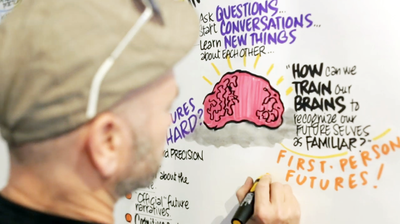Future Now
The IFTF Blog
Train Your Brain to Prepare
Our brains think of our future selves as strangers and have built-in anxiety about change. This human tendency and our cognitive bias against thinking that the future might be any different than the present should be of concern to anyone who wants to make reasonable plans for themselves, their companies, or their communities. Luckily, as I learned during Institute for the Future (IFTF)’s Foresight Essentials Training last December, there are multiple methods for “pre-experiencing” the future that allow us to create plausible scenarios, and therefore prepare better for what might come.
For three days, a diverse cohort of 30 participants and I learned how to broaden our horizons and challenge the assumptions we hold, anticipate long-term threats and opportunities, and practice writing forecasts. IFTF has a toolkit of 22 different tools that has been used thousands of times across a range of contexts and focus areas, from private corporate scenario forecasting to social questions that are philosophically changing our world, like the future of immigration.
 As a group, we went through this toolkit, learning how to best use each tool, and then applied them to the overarching topic of “the future of communication.” We learned how to make connections between possible futures and their potential chain reactions (or “drawn out consequences”). We practiced combining seemingly disparate signals of change to unstick our brains and “Reveal Unexpected Possibilities,” another one of the well-tested tools that allows us to work outside of our assumptions.
As a group, we went through this toolkit, learning how to best use each tool, and then applied them to the overarching topic of “the future of communication.” We learned how to make connections between possible futures and their potential chain reactions (or “drawn out consequences”). We practiced combining seemingly disparate signals of change to unstick our brains and “Reveal Unexpected Possibilities,” another one of the well-tested tools that allows us to work outside of our assumptions.
In learning about these tools, we also learned crucial facilitation elements. The teaching team taught us how to use each tool and how we might bring them back to our own companies, clients, and communities. For example, during an icebreaker activity, “Orient to the Future,” we lined up in order of how much we responded to certain statements (I feel very—or not—optimistic about the future). We learned that this a good way to get participants physically moving, and that it becomes a good barometer for the facilitators to get a sense of the overall feelings in the room. Is this a crowd that feels particularly rosy about the future and their prospects? Then make sure to do some collapse scenarios to inspire new ideas. Is this room full of doom and gloom? Make sure to bring in positive stories and transformation scenarios.
The mix of people in the room contributed to the learning—and also the fun! Attendees came from all over the world, and from backgrounds as varied as education policy, corporate telecom, tech innovation, social and racial equity, health, literature, and creating personal resilience. Using the tools with them gave me insight into how people in other sectors are thinking about the future, and helped expand my own thinking and understanding of how all of these sectors are increasingly intertwined.
All of this came in quite useful in a meeting I had just a few weeks later with a client who is new to foresight and was trying to wrap their head around some concepts I presented for an upcoming workshop. I named a few of the tools and gave examples of how we’d use them together in an interactive workshop. They quickly grasped the content as well as the value of using these tools to expand their own imagination in thinking about their future.
IFTF’s Foresight Essentials Training not only gave me tools with which I can place myself in future scenarios and be more at ease with uncertainty, but it also gave me the skills I need to share these tools and learnings with others.
For information on IFTF Foresight Essentials trainings, please contact:
Neela Lazkani nlazkani@iftf.org | 650.233.9562



